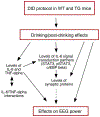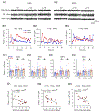Neuroimmune interactions with binge alcohol drinking in the cerebellum of IL-6 transgenic mice
- PMID: 36775097
- PMCID: PMC10029700
- DOI: 10.1016/j.neuropharm.2023.109455
Neuroimmune interactions with binge alcohol drinking in the cerebellum of IL-6 transgenic mice
Abstract
The neuroimmune system of the brain, which is comprised primarily of astrocytes and microglia, regulates a variety of homeostatic mechanisms that underlie normal brain function. Numerous conditions, including alcohol consumption, can disrupt this regulatory process by altering brain levels of neuroimmune factors. Alcohol and neuroimmune factors, such as proinflammatory cytokines IL-6 and TNF-alpha, act at similar targets in the brain, including excitatory and inhibitory synaptic transmission. Thus, alcohol-induced production of IL-6 and/or TNF-alpha could be important contributing factors to the effects of alcohol on the brain. Recent studies indicate that IL-6 plays a role in alcohol drinking and the effects of alcohol on the brain activity following the cessation of alcohol consumption (post-alcohol period), however information on these topics is limited. Here we used homozygous and heterozygous female and male transgenic mice with increased astrocyte expression of IL-6 to examined further the interactions between alcohol and IL-6 with respect to voluntary alcohol drinking, brain activity during the post-alcohol period, IL-6 signal transduction, and expression of synaptic proteins. Wildtype littermates (WT) served as controls. The transgenic mice model brain neuroimmune status with respect to IL-6 in subjects with a history of persistent alcohol use. Results showed a genotype dependent reduction in voluntary alcohol consumption in the Drinking in the Dark protocol and in frequency-dependent relationships between brain activity in EEG recordings during the post-alcohol period and alcohol consumption. IL-6, TNF-alpha, IL-6 signal transduction partners pSTAT3 and c/EBP beta, and synaptic proteins were shown to play a role in these genotypic effects.
Keywords: EEG; IL-6; STAT3; Signal transduction; Synapse; TNF-alpha; c/EBP beta; pSTAT3.
Copyright © 2023 Elsevier Ltd. All rights reserved.
Conflict of interest statement
Declaration of competing interest The authors have no conflict of interest to declare.
Figures






Similar articles
-
Impact of Elevated Brain IL-6 in Transgenic Mice on the Behavioral and Neurochemical Consequences of Chronic Alcohol Exposure.Cells. 2023 Sep 19;12(18):2306. doi: 10.3390/cells12182306. Cells. 2023. PMID: 37759527 Free PMC article.
-
Altered brain activity during withdrawal from chronic alcohol is associated with changes in IL-6 signal transduction and GABAergic mechanisms in transgenic mice with increased astrocyte expression of IL-6.Neuropharmacology. 2018 Aug;138:32-46. doi: 10.1016/j.neuropharm.2018.05.024. Epub 2018 May 19. Neuropharmacology. 2018. PMID: 29787738 Free PMC article.
-
Characterization of the Hippocampal Neuroimmune Response to Binge-Like Ethanol Consumption in the Drinking in the Dark Model.Neuroimmunomodulation. 2019;26(1):19-32. doi: 10.1159/000495210. Epub 2019 Jan 9. Neuroimmunomodulation. 2019. PMID: 30625475 Free PMC article.
-
GABAAR α2-activated neuroimmune signal controls binge drinking and impulsivity through regulation of the CCL2/CX3CL1 balance.Psychopharmacology (Berl). 2019 Oct;236(10):3023-3043. doi: 10.1007/s00213-019-05220-4. Epub 2019 Apr 27. Psychopharmacology (Berl). 2019. PMID: 31030249 Review.
-
Neuroimmune Function and the Consequences of Alcohol Exposure.Alcohol Res. 2015;37(2):331-41, 344-51. Alcohol Res. 2015. PMID: 26695754 Free PMC article. Review.
Cited by
-
Age- and cytokine-dependent modulation of GABAergic transmission within the basolateral amygdala of male Sprague Dawley rats.Neuropharmacology. 2025 Apr 1;267:110304. doi: 10.1016/j.neuropharm.2025.110304. Epub 2025 Jan 17. Neuropharmacology. 2025. PMID: 39827996
-
Astrocytes and Alcohol Throughout the Lifespan.Biol Psychiatry. 2025 Apr 30:S0006-3223(25)01147-3. doi: 10.1016/j.biopsych.2025.04.013. Online ahead of print. Biol Psychiatry. 2025. PMID: 40311830 Free PMC article. Review.
-
Sex-dependent factors of alcohol and neuroimmune mechanisms.Neurobiol Stress. 2023 Aug 3;26:100562. doi: 10.1016/j.ynstr.2023.100562. eCollection 2023 Sep. Neurobiol Stress. 2023. PMID: 37601537 Free PMC article.
-
Impact of Elevated Brain IL-6 in Transgenic Mice on the Behavioral and Neurochemical Consequences of Chronic Alcohol Exposure.Cells. 2023 Sep 19;12(18):2306. doi: 10.3390/cells12182306. Cells. 2023. PMID: 37759527 Free PMC article.
-
Potentiation of the depressant effect of alcohol by flunitrazepam in rats: an electrocorticographic, respiratory and electrocardiographic study.Naunyn Schmiedebergs Arch Pharmacol. 2024 Oct;397(10):7599-7613. doi: 10.1007/s00210-024-03111-w. Epub 2024 Apr 27. Naunyn Schmiedebergs Arch Pharmacol. 2024. PMID: 38676788
References
Publication types
MeSH terms
Substances
Grants and funding
LinkOut - more resources
Full Text Sources
Miscellaneous

